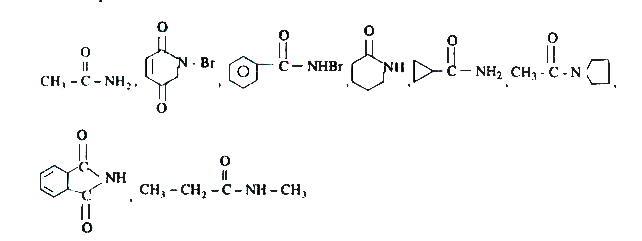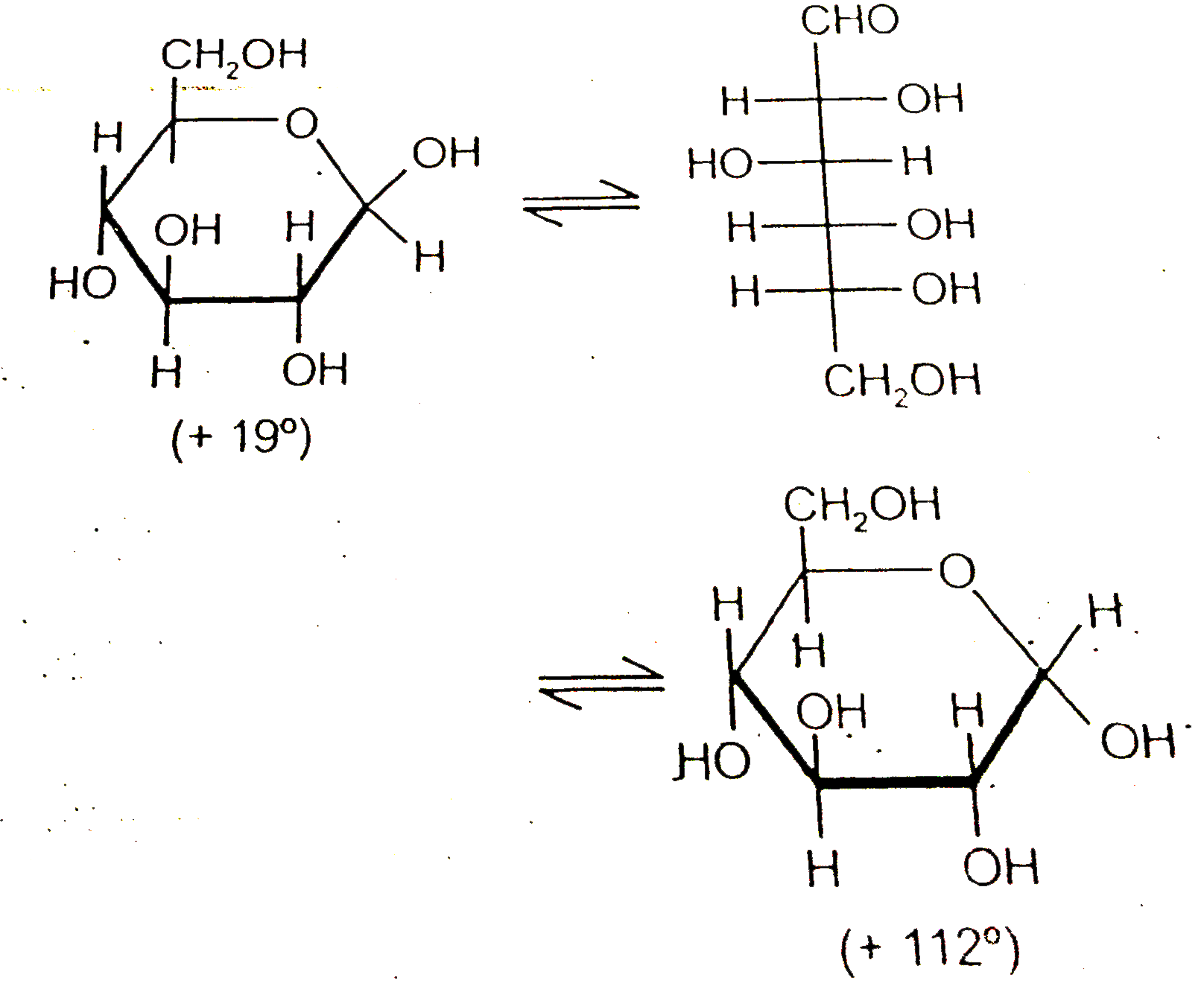D(+) Glucose has melting point 140∘C and specific rotation [a]25D is 112∘C. Another D(+) Glucose has melting point 150∘C and specific rotation [a]25D is +18.7∘C. The two form have significantly different optical rotation but when an aqueous solution of either form is allowed to stand, it rotation changes. The specific rotation of one form decreases and rotation of other increases until both solution show the same value +52.7∘. The change in rotation towards an equilibrium value is called mutarotation
^(25) is 112^(@)C. Another D(+) Glucose has melting point 150^(@)C and specific rotation [a](D)^(25) is +18.7^(@)C. The two form have significantly different optical rotation but when an aqueous solution of either form is allowed to stand, it rotation changes. The specific rotation of one form decreases and rotation of other increases until both solution show the same value +52.7^(@). The change in rotation towards an equilibrium value is called mutarotation [alpha](D)^(25) = +18.7^(@)C](https://d10lpgp6xz60nq.cloudfront.net/physics_images/AKS_TRG_AO_CHE_XII_V02_A_C01_E05_019_Q01.png)
[α]25D=+18.7∘C [α]25D=+112∘C
For mannose the mutarotation can be shown in brief as follow
 Solution in Telugu
Solution in Telugu
α-form
β−form
open chain
none of these
The correct Answer is:B
Mutarotation
Topper's Solved these Questions
- BOOK - AAKASH SERIESCHAPTER - CARBOHYDRATESEXERCISE - Practice Sheet-430videos
CARBOHYDRATES
- BOOK - AAKASH SERIESCHAPTER - CARBOHYDRATESEXERCISE - Practice Sheet-530videos
CARBOHYDRATES
- BOOK - AAKASH SERIESCHAPTER - CARBOHYDRATESEXERCISE - Practice Sheet-230videos
CARBOHYDRATES
- BOOK - AAKASH SERIESCHAPTER - BIOMOLECULESEXERCISE - OBJECTIVE EXERCISE-4 (ASSERTION (A) & REASON (R) TYPE QUESTIONS :)84videos
BIOMOLECULES
- BOOK - AAKASH SERIESCHAPTER - CARBOXYLIC ACIDS EXERCISE - PRACTICE SHEET-4 (Integer Type Questions)9videos
CARBOXYLIC ACIDS
Similar Questions
Sugars are characterized by the preparation of Osazone derivatives. Which sugars have identical osazones
09:08View SolutionD-tagatose is a 2-ketohexose which forms same osazone as D-galactose. What is the structure of D-tagatose
09:08View SolutionWhich of the following statement is correct
09:08View Solution(A) Fructose has ketone group and does not reduce Tollen's reagent.
(R) Fructose in Haworth structure has SiX membered ring.05:30View SolutionHow many of the following compounds will give Hoffman Hypo bromide reaction.
 04:13View Solution
04:13View SolutionD(+) Glucose has melting point 146∘C and specific rotation [α]C6(25) is +122∘C. Another D(+) Glucose has melting 150∘C and specific rotation [α]25D is +18.7∘C. The two form have significantly different optical rotation but when an aqueous solution of either form is allowed to stand, it rotation changes. The specific rotation of one form decrease and rotation of other increases until both solution show the same value +52.7∘. The change in rotation towards an equilibrium value is called mutarotation.

Mutarotation is characteristic feature of05:11View SolutionD(+) Glucose has melting point 146∘C and specific rotation [α]C6(25) is +122∘C. Another D(+) Glucose has melting 150∘C and specific rotation [α]25D is +18.7∘C. The two form have significantly different optical rotation but when an aqueous solution of either form is allowed to stand, it rotation changes. The specific rotation of one form decrease and rotation of other increases until both solution show the same value +52.7∘. The change in rotation towards an equilibrium value is called mutarotation.

What percentage of β-D-(+) glucopyrnsone found at equillibrium in the aqueous solution?05:11View SolutionD(+) Glucose has melting point 146∘C and specific rotation [α]C6(25) is +122∘C. Another D(+) Glucose has melting 150∘C and specific rotation [α]25D is +18.7∘C. The two form have significantly different optical rotation but when an aqueous solution of either form is allowed to stand, it rotation changes. The specific rotation of one form decrease and rotation of other increases until both solution show the same value +52.7∘. The change in rotation towards an equilibrium value is called mutarotation.

For mannose the mutarotation can be shown in brief as follow:
 View Solution
View SolutionWhen either form of D-Glucose is dissolved In water, the solution gradually changes its optical rotation and finally attains a constant optical rotation of +52^(@) . Which form of D-GIucose is more stable?
03:46View SolutionWhen either form of D-Glucose is dissolved In water, the solution gradually changes its optical rotation and finally attains a constant optical rotation of +52∘.

What is the percentage of open chain D-Glucose in solution?03:24View SolutionThe beta and alpha glucose have different specific rotations. When either is dissolved in water, their rotation changes until the same fixed value results. This is called
02:08View SolutionThe beta and alpha glucose have different specific rotations. When either is dissolved in water , their rotation changes until the same fixed value results. This is called
05:38View Solutionα-D-ग्लूकोस तथा β-D-ग्लूकोस के विशिष्ट घूर्णन का मान बताइए।
02:45View SolutionGlucose shows mutarotation when it dissolves in water. The specific rotation of α-D glucose and β-D- glucose is +112.2∘ and +18.7∘ respectively. Calculate the percentage of two anomers present at equilibrium mixture with a specific rotation of +52.6∘.
07:10View SolutionForeword: Freshly made alpha - Specific rotation of glucose solution + 112^(@) From 52.7^(@) While lowering beta Specific rotation of freshly made solution of glucose + 19^(@) From 52.7^(@) Rises to Reason: of an optically active compound. The change in specific rotation over time up to the equilibrium value is called mutarotation.
04:49View Solution

